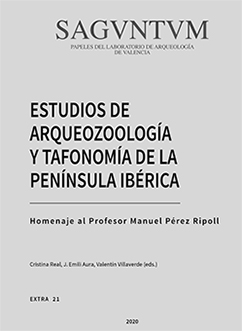Early development of the European rabbit (Oryctolagus cuniculus L. 1758): an osteometrical tool to address taphonomical and archaeozoological issues
Palabras clave:
archaeozoology Resumen
Resumen
The skeletal development of the European rabbit during its first weeks of life is a poorly documented phenomenon whose potential applications reach to various fields of research. In this paper a table is provided to turn the lengths of seven skeletal elements (mandible, humerus, radius, ischium, ilium, femur and tibia) into weight and age equivalents. The database consisted of sixteen rabbits of known size and weight from the same population whose ages were previously estimated through the application of widely used age-weight regression equations. This reference should allow faunal analysts to recognize those size thresholds for each element below which rabbits are not able to leave the burrow, a feature that will help spot them as intrusive elements in archaeological deposits.
 Descargas
Descargas
Descargas
Publicado
Cómo citar
-
Resumen473
-
PDF 258
Número
Sección
Licencia

Este obra está bajo una licencia de Creative Commons Reconocimiento-NoComercial-SinObraDerivada 4.0 Internacional.
Con la publicación impresa de los trabajos, los/as autores/as aceptan que el Departament de Prehistòria, Arqueologia i Història Antiga de la Universitat de València pueda permitir la difusión y el libre acceso a través de las direcciones electrónicas y enlaces del editor/a.
El contenido de los trabajos es responsabilidad de los/as autores firmantes y no expresa la posición ni la opinión del Consejo de Redacción.
Las obras que se publican en esta revista están sujetas a los siguientes términos:
1. La revista conserva los derechos patrimoniales (copyright) de las obras publicadas, y favorece y permite la reutilización de las mismas bajo la licencia indicada en el punto 2.
2. Las obras se publican en la edición electrónica de la revista bajo una licencia Creative Commons Reconocimiento-NoComercial-SinObraDerivada 3.0 España (texto legal). Se pueden copiar, usar, difundir, transmitir y exponer públicamente, siempre que se cite la autoría, la url, y la revista, y no se usen para fines comerciales.
3. Los/as autores/as están de acuerdo con la licencia de uso utilizada por la revista, con las condiciones de auto-archivo y con la política de acceso abierto.
4. En caso de reutilización de las obras publicadas debe mencionarse la existencia y especificaciones de la licencia de uso además de mencionar la autoría y fuente original de su publicación.



